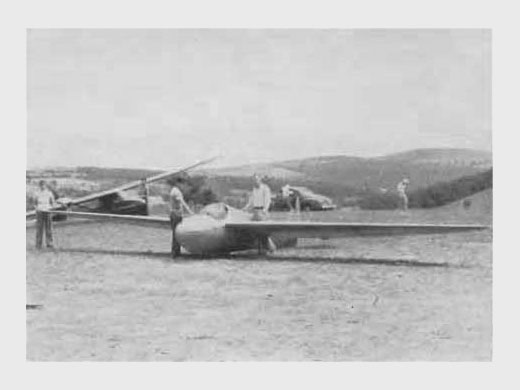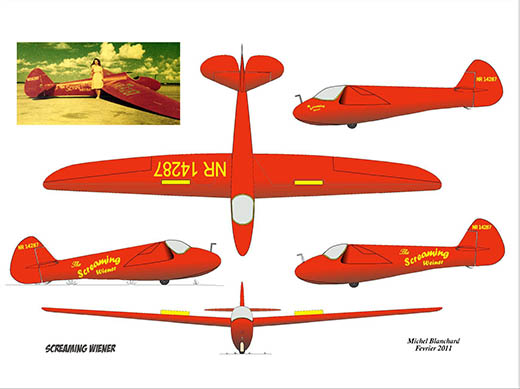
Culver Screaming Wiener
| DONNÉES GÉNÉRALES |
| Année du premier vol (ou de design, si seul projet) |
1940 |
| Pays | USA |
| Designer(s) | CULVER, Irvin |
| Premier constructeur | CULVER, Irvin & NEUGENT, Wally & BURKE, Walter |
| Type d'appareil | Planeur |
| Fonction | Entraînement |
| SPÉCIFICATIONS TECHNIQUES |
| Envergure | 11.2 m |
| Longueur | 5.58 m |
| Hauteur | -- |
| Allongement | 14 |
| Surface alaire | -- |
| Profil aile | -- |
| Masse à vide | -- |
| Masse maxi | 258 kg |
| Charge alaire | -- |
| Vitesse mini | -- |
| Vitesse maxi | -- |
| Finesse maxi | 21 |
| Taux de chute mini | 1.55 m/s |
| Nb sièges | 1 |
| Structure | Bois et toile. |
AUTRES INFORMATIONS
| Constructeur(s) |
| ||||||
| Infos techniques | The fuselage was made of plywood, and the wooden tail surfaces and wings were fabric covered. Because its all-up weight was only 500 pounds, this maneuverable glider could work well in very small thermals. | ||||||
| Histoire résumée | En 1938, trois membres du Crown City Glider Club de Pasadena, Californie, USA, démarrent la construction d'un petit planeur : Irvin Culver avait fait les dessins, et Wally Neugent et Walter Burke l'aident à la construction. C'est la dimension du garage dans lequel se fit la construction qui imposa l'envergure du planeur ! In 1939, Irv. Culver test-flew his plane at Tehachapi, CA. Because of the distinctive whistling sound it made in flight and its bright red paint job, the ship was dubbed "Screaming Wiener". In 1941, it was flown at the Arvin Meet by Wally Neugent (one of the original builders) and at the Southwest Soaring Contest in Wichita Falls, TX. After being flown at Arvin in 1941, it was sold to Frank Boggs, who flew it at the Elmira 1941 Nationals and recorded a flight of 1 hour, 20 minutes. Frank then took the Wiener to Rosemond Dry Lake, CA, where he and several other pilots made many flights by auto tow, the longest of which was 2 hours, 10 minutes at 5,000 feet. After Frank Boggs' death, the ship was sold back to the Crown City Glider Club, but it wasn't flown until 1944 at Bishop, CA. Two more years went by before the Wiener took to the sky again - this time in Twentynine Palms, CA, with Ray Parker at the controls. Ray made several cross-country flights, including one all the way to Wickenburg, AZ. He placed second at the 1946 Nationals at Elmira, NY with the Wiener. Next, the club sold the ship to Paul Tuntland, who took it to Sanford, FL, where he attained an altitude flight of 15,500 feet. The Wiener was then acquired by Paul MacCready, Jr. of New Haven, CT, who took the ship to the Nationals at Wichita Falls, TX. In just over two weeks, Paul recorded more than 1,870 cross-country miles and two gold "C" legs, and set a world out-and-return record of 230 miles! In 1948, Gordon Winfield bought the plane. He re-covered and painted it, but never flew it. He sold the ship to Beaumont Cooley, Jr. the same year. Beaumont flew the ship in Grand Prairie and Odessa, TX until 1951. His flying included airshow aerobatics, a Gold "C" altitude and cross-country flight of 154 miles. Le planeur fut racheté, vers 1950-51 par Wally Wiberg, de Grand Prairie, Texas, qui le baptisa "Li'l Dogie", et fit quelques modifications avant de le faire voler. [voir fiche Culver Li'l Dogie]. | ||||||
| Liens personnalités | Pas de personnalité associée. | ||||||
| Remarques | Voir la fiche Culver Li'l Dogie. Wiener : Saucisse de Francfort. Screaming : qui pousse des cris perçants. | ||||||
| Compléments docs |
SOURCES DOCUMENTAIRES
| Liens WEB | Site : soaringweb.org . The story of the Screaming Wiener [Soaring Magazine nov-dec 1941]. (2010-01-01) Site : Vintage Sailplanes . Li'l Dogie, or formerly called Screamin Wiener.... (2010-01-01) |
| Livres | Pas de livre référencé. |
| Autres sources | The story of the Screaming Wiener, par Wally Neugent, Soaring Magazine, novembre-décembre 1941 page 6 Soaring juillet-août 1947 p 8. Petite photo. |

Team J2mcL © 2003 -
- Pages optimisées pour Mozilla Firefox

